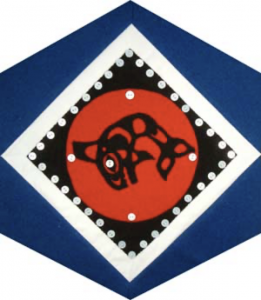Tsimshian

The Block
This block, patterned after a traditional button-blanket, was made by Melodie Johnson (of Terrance, B.C.’s Kitsumkalum band), who learned the craft as a teenager. Melodie draws design ideas from her dreams, and although each intricate pattern created sends a message, no two are ever identical. A dream of the woman spirit, who protects the tribe, was the inspiration for this particular piece. The red Melton cloth represents the women who are the givers of life, populating the tribes, while the circle signifies the cycles of life. Four mother-of-pearl buttons mark the cardinal directions, and represent air, water, land, and animals. An abalone-shell eye gives the whale sight and honours the fact that Tsimshian live off the land, the animals and creatures of the sea. Melodie chose this very simple, old-style Blackfish design to honour the people who have passed on the wisdom of her ancestors.
Cultural Profile
The Tsimshian, or Chimmesyan, settled centuries ago along the north-west coast of British Columbia, around the Skeena and Nass Rivers. There are four Tsimshian, or Sm’álgyax, dialects: Nisga’a, Northern and Southern Tsimshian and Gitsxan. Similar to other northwest coast First Nations groups, fishing was the mainstay of the Tsimshian diet and economy––the oil extracted from the Eulachon (or oolichan) fish was a valuable trading commodity and also had many uses in the home. Tsimshian groups living further inland also hunted bear, mountain goats, caribou, deer and some small-game animals.
The Tsimshian moved with the seasons, constructing large, permanent, wood dwellings at each location. These houses were decorated with carvings and paintings that served as indicators of social status. Tsimshian society was organized along maternal clan lines. Each clan held claim to specific fishing and hunting areas, and places to pick berries or gather plants. The family, or clan, crests were also considered property. Each clan held claim to specific fishing and hunting areas, and places to pick berries or gather plants. The family, or clan, crests were also considered property. Each clan––several of which together formed a tribe––was represented by their own chief, with the chief of the highest ranking clan serving as tribal chief.
The Tsimshian are renowned for their totem-making abilities. These tall, carved and painted structures were often erected to honour deceased chiefs. The induction of a new chief was celebrated with a potlatch, complete with a gift-giving ceremony. The women were highly adept at weaving and basketry, skills that are currently being revitalized. Tsimshian self-form geometric and abstract art reflects the legends, myths, and folktales of the people.
Sponsor: Plantagenet Women’s Institute
